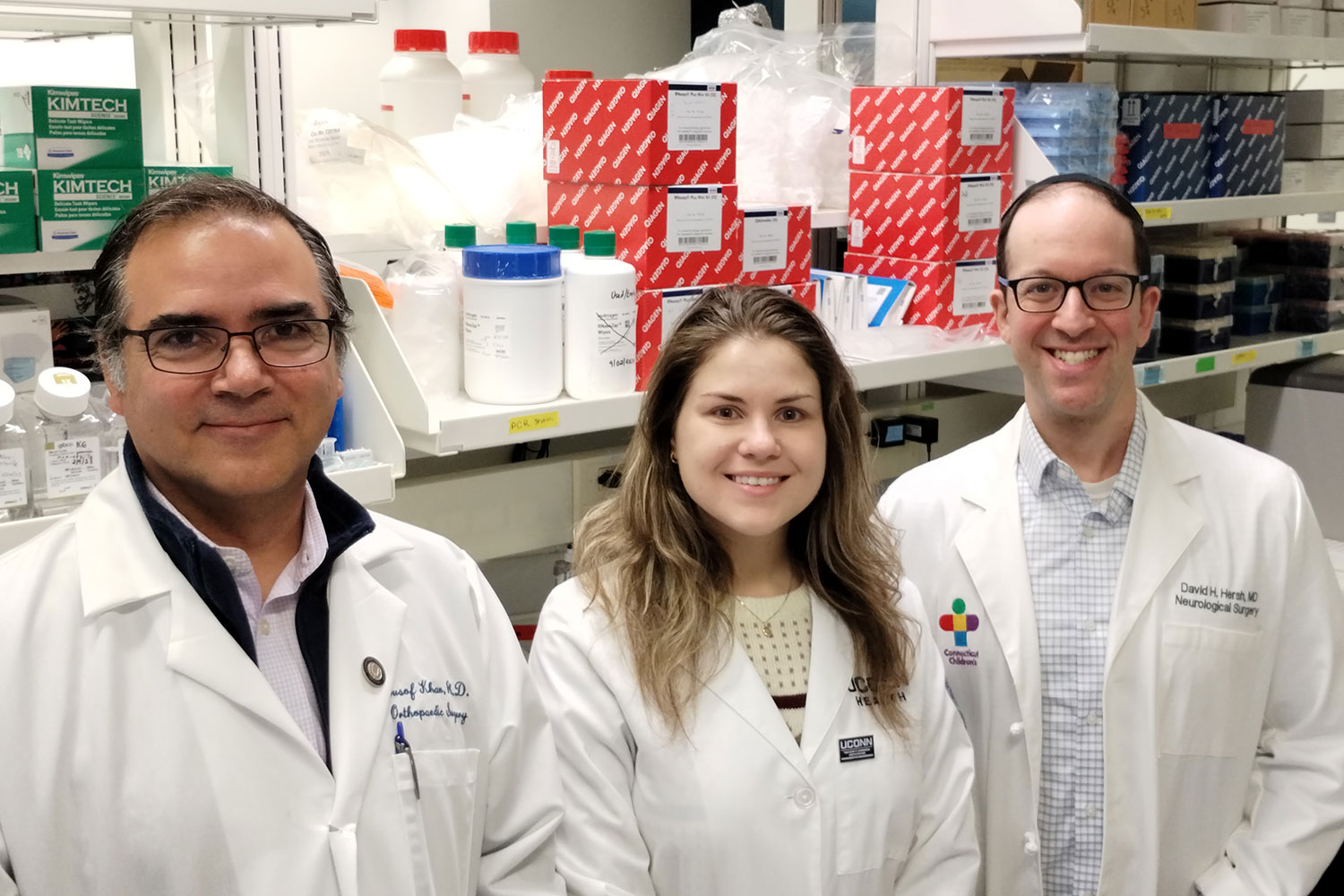The UConn School of Engineering has produced countless outstanding engineers during our century of engineering instruction. Among them are several individuals whose accomplishments warranted acceptance into the National Academy of Engineering (NAE) and National Academy of Sciences (NAS). We are delighted to introduce them to you below:
 Dennis M. Bushnell (B.S.E. Mechanical Engineering ’63)
Dennis M. Bushnell (B.S.E. Mechanical Engineering ’63)
NAE Induction: 1998
Citation: For viscous flow modeling and control, turbulent drag reduction, and advanced aeronautical concepts.
Dennis M. Bushnell (M.S., FASME, FAIAA, FRAS) is Chief Scientist at NASA Langley Research Center. During his lengthy career, he has served as Research Scientist, Section Head, Branch Head, Associate Division Chief and Chief Scientist in Flow Modelling and Control across the Speed Range, Advanced Configuration Aeronautics, Aeronautical Facilities and Hypersonic Airbreathing Propulsion. Mr. Bushnell developed the “riblet” approach to turbulent drag reduction, high speed “quiet tunnels” for flight-applicable boundary layer transition research, advanced computational approaches for laminar flow control and advanced hypervelocity airbreathing and aeronautical concepts with revolutionary performance potential. He served the Gemini, Apollo, Viking, F-18E/F and Shuttle programs. He is a Fellow of ASME, AIAA, and the Royal Aeronautical Society. He has received numerous honors, including the Lawrence A. Sperry Award (’75), the AIAA Fluid and Plasma Dynamics Award, the AIAA Dryden Lectureship, USAF/NASP Gene Zara Award, NASA Exceptional Scientific Achievement and Outstanding Leadership Medals and Distinguished Research Scientist Awards. Mr. Bushnell holds five patents. A member of the University of Connecticut Academy of Distinguished Engineers and a recipient of the Distinguished Alumni Award in 1997, he serves on the UConn Engineering Advisory Board. Mr. Bushnell earned his M.S. degree from the University of Virginia in 1967.
 Anthony J. DeMaria (B.S. Electrical Engineering ’56, Ph.D. Electrical Engineering ’65)
Anthony J. DeMaria (B.S. Electrical Engineering ’56, Ph.D. Electrical Engineering ’65)
NAE induction: 1976
Citation: Developer of picosecond mode-locked lasers and contributions to high power lasers.
NAS induction: 1997
Citation: DeMaria’s pioneering research in picosecond laser pulse physics profoundly influenced the study of molecular and atomic dynamics, nonlinear optics, and plasma physics. He is credited with the first demonstration of picosecond laser pulses and contributed greatly to their generation, amplification, measurement, and applications.
Dr. Anthony DeMaria is Chief Scientist with Coherent-DEOS, LLC, Bloomfield, CT, which manufactures lasers used primarily in material processing applications. He is also a Distinguished Professor-in-Residence in the UConn Electrical & Computer Engineering Department. Dr. DeMaria founded DeMaria Electro-Optics Systems, Inc. (DEOS) in 1994 after purchasing intellectual property of the CO2 laser unit of Hamilton Standard. He was chairman and CEO of DEOS, polishing the company into the world’s leading manufacturer of sealed-off, RF excited waveguide CO2 lasers for industrial and governmental applications. The company was purchased in 2001 by Coherent, Inc. Before founding DEOS, Dr. DeMaria devoted 37 years of his career to the Hamilton Standard (now Hamilton Sundstrand) division of United Technologies Corporation and to the United Technologies Research Center. In addition to the National Academies of Engineering and Sciences, Dr. DeMaria is a co-founder, member and past president of the Connecticut Academy of Science & Engineering (CASE) and the Connecticut Academy of Arts and Sciences. He is a Fellow of the American Physical Society and IEEE, and a Fellow and past president of both the Optical Society of America and SPIE. He received the 1980 IEEE Morris N. Liebmann Memorial Award “for contributions to the initiation and demonstration of the first picosecond optical pulse generator,” the 2004 Connecticut Medal of Technology, and the 1983 UConn Distinguished Engineering Alumni Award. Dr. DeMaria holds 55 U.S. patents. He was inducted into the UConn Academy of Distinguished Engineers in 2004.
 Daniel E. Noble (B.S. Electrical Engineering ’29) 1901-1980
Daniel E. Noble (B.S. Electrical Engineering ’29) 1901-1980
NAE induction: 1968
Citation: Leadership in the development of a wide variety of electronic devices and systems.
Daniel E. Noble originated the nation’s first two-way state police system placed online, and the first practical two-way FM radio telephone mobile system in the world. Based on this success, he was invited to join Galvin Manufacturing Corp. (later changed to Motorola, Inc.) in 1940 as Director of Research. He developed FM communications equipment for police and the U.S. Signal Corps, and was directly responsible for the systems concept and the direction of the development of the U.S. Army’s SCR-300 FM Walkie-Talkie. In 1949, he set up a solid state electronics research laboratory for Motorola in Phoenix that eventually led to the establishment of the Semiconductor Products Division (now the Semiconductor Group). Dr. Noble held a variety of positions, including Director of Research; General Manager of the Communications Division; Vice President and Director of Motorola, Inc.; Vice President and Director in charge of the Communications Division; Group Executive Vice President and Vice Chairman of the Board and Chief Technical Officer of the Corporation. He retired from Motorola in 1970 but served as Chair of the Science Advisory Board.
He held nine patents on electronics and was a Life Fellow of the IEEE and the Franklin Institute. He was awarded the WEMA Medal of Achievement, the Franklin Institute’s Stuart Ballantine Medal and the University of Connecticut Engineering Alumni Plaque. He was the 1978 IEEE Edison Medal Recipient “For leadership and innovation in meeting important public needs, especially in developing mobile communications and solid-state electronics.” IEEE established the Daniel E. Noble Award in 2000 to honor outstanding contributions to emerging technologies recognized within recent years.
 Louis Parrillo, Ph.D. (B.S. Electrical Engineering ’64).
Louis Parrillo, Ph.D. (B.S. Electrical Engineering ’64).
NAE Induction: 1996
Citation: For contributions to device and fabrication technology for integrated circuits.
Dr. Louis Parrillo is Executive Vice President of Research and Development at Spansion, Inc., Sunnyvale, CA. He is responsible for technology development and strategic alliances. A pioneer in the semiconductor industry, Dr. Parrillo has received many prestigious honors for his innovations, including 26 patents. He is a recipient of the IEEE Frederik Philips Award, the J. J. Ebers Award from the IEEE Electron Devices Society, and many others. Prior to joining Spansion, Dr. Parrillo managed his own consulting firm while also serving on Cypress Semiconductor’s Technology Advisory Board since 2004. He was with Motorola Inc. for 19 years and held various executive management roles, including Division General Manager and Semiconductor Chief Technology Officer. As CTO, he and his colleagues drove the formation of the alliance among Motorola, ST Microelectronics, Philips Semiconductor and TSMC for the research, development and transfer-to-manufacturing of advanced 300mm-wafer technology in Crolles, France. Earlier in his career, he was employed with AT&T Bell Laboratories, Murray Hill, NJ, where he was a co-developer of the original Twin-Tub CMOS technology that became an industry standard for more than two decades.
Dr. Parrillo earned his M.S. and Ph.D. degrees in electrical engineering from Princeton University.
 Kumares C. Sinha, Ph.D. (M.S. Municipal Engineering ’66, Ph.D. Civil Engineering ’68)
Kumares C. Sinha, Ph.D. (M.S. Municipal Engineering ’66, Ph.D. Civil Engineering ’68)
NAE Induction: 2008
Citation: For contributions to the advancement of highway infrastructure engineering and management and to the education of transportation professionals worldwide.
Dr. Kumares C. Sinha is the Edgar B. & Hedwig M. Olson Distinguished Professor of Civil Engineering and Director of the Joint Transportation Research Program of Purdue University and the Indiana Department of Transportation. He joined Purdue in 1974 following six years at Marquette University. He was a Visiting Professor at the Massachusetts Institute of Technology and Roorkee University, India (now IIT-Roorkee) during 1980-81. He is an internationally recognized leader in research, education and practice of transportation engineering. His research on pavement and bridge performance, life cycle costing, optimal timing of repair and renewal, and road safety has contributed to the establishment of the field of highway infrastructure management. He has published extensively, including a book on transportation decision making, has mentored a generation of students, advised governments at all levels, and consulted for the World Bank on transportation and infrastructure issues. He served as the President of the Transportation & Development Institute of the American Society of Civil Engineers (ASCE), President of the Research and Education Division of the American Road and Transportation Builders Association (ARTBA), President of the Council of University Transportation Centers (CUTC), and as a member of the Federal Advisory Council on Transportation Statistics. He is currently the Editor-in-Chief Emeritus of the Journal of Transportation Engineering. He received many honors, including the Honorary Membership of ASCE (2005), CUTC Distinguished Contribution Award (2005), ITE Wilbur S. Smith Distinguished Educator Award (2002), ASCE Francis C. Turner Lecture Award (2001), ARTBA Steinberg Award (2000), ASCE Harland Bartholomew Award (1996), ASCE Arthur Wellington Prize (1992), ASCE Frank M. Masters Award (1986), TRB Fred Burggraf Award (1974), and the UConn Distinguished Engineering Alumni Award (1995). He was inducted into the UConn Academy of Distinguished Engineers in 2004. He is married to Anne Elizabeth Kallina (B.A. ’68).


